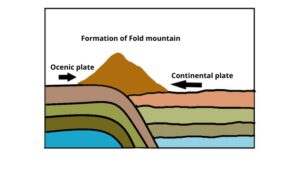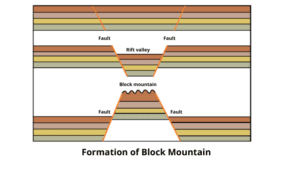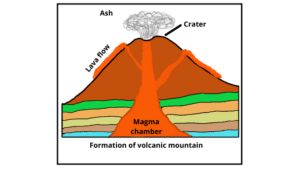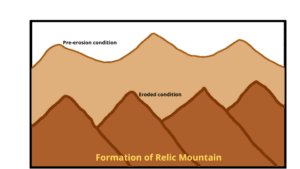Introduction
The earth’s crust takes various forms due to its origins and various effects of corrosive forces as a result, different parts of the earth’s surface have different heights called landforms. There are many variations that can be observed on the surface of the earth. These variations were not present at the beginning of the creation of the earth. The earth was hot and gaseous when it was first created later, gradually cooled, creating continents and oceans. Between these two forms, various changes take place in the land at the bottom of the ocean and on the surface of the continent. According to the difference in land elevation of the continent, there are three types of topography. The mountain is one of these landforms. Below is a discussion of how mountains are formed (1) & (4).
What is a mountain?
A mountain is a landform on the surface of the earth that has the highest peak, extends far, high, and has steep slopes that are generally wide and rocky. The topmost, narrowest part of the mountain is called the mountain peak they are often covered with white snow. Many peaks are called mountain ranges when they cover a large valley (2).
Example
The Himalayas of Asia, the Alps of Europe, the Andes of South America, etc. are examples of mountains (1).
Properties of mountain
- The mountains are very high.
- Mountains have more differences in relative height.
- The mountains extend far and wide.
- The mountain peaks located on the top of the mountains are always sky-touching.
- Mountains are one-fourth of the earth.
- Mountains are much higher than local heights. These are thousands of meters or more high (3) & (5).
Formation of mountains
The size and height of the mountains are the largest among the landforms on the earth’s surface. Therefore, geologists have always been curious to know the reason for mountain formation.
Different processes work together in the formation of mountains called Orogenesis. The Greek word ‘Ares’ means ‘mountain’ and genesis means ‘creation’.
The combination of these two words has given rise to the word ‘Orogenesis’, which means the process of mountain formation. According to the origin and variety of structure, the mountains are mainly divided into four types. These are fold mountains, block mountains, volcanic mountains, and relict mountains. Below is a brief discussion of how all these mountains are formed (5).
1. Fold Mountain
 Definition
Definition
The rock of the earth’s crust is arranged in layers. The mountain that is formed by folding in this rock layer is called Fold Mountain. The fold mountain is formed by many folds.
Although fold mountains are usually composed of sedimentary rocks, they sometimes contain igneous and metamorphic rocks. The upper fold of the fold mountain is called the anticline and the lower fold is called the syncline.
There are many peaks located in the Fold Mountains. The formation of Fold Mountain is not stable. Fossils can be seen in this mountain due to their origin from the sedimentary rocks of the sea (2) & (5).
Example
The Himalayas of India, the Alps, and Jura of Europe, the Atlas of Africa, the Rocky of North America, etc. are examples of the Fold Mountains (1).
Formation
There are various theories about the cause of the formation of the Fold Mountains. The main two theories are
- Geosyncline theory
According to this theory- in ancient periods, there was a large hole in the area where now the Fold Mountains are located. In geological terms, the name of these large holes is geosyncline. Sediment accumulates over the year and as a result, this geosyncline is almost filled.
Continuous sedimentation causes downward and lateral pressure at ground level. And as a result, the accumulated silt of the geosyncline begins to fold. Later these folds became higher and formed the fold mountain.
- Plate tectonic theory
According to the plate tectonic theory, the lithosphere consists of some plates. These plates are dynamic. They float on a very hot and liquid magma layer at the bottom of the mantle.
Each plate can consist of only continents or oceans or a combination of both such as the Eurasian plate, the African plate, the Indian plate, the Pacific plate, etc. These plates become dynamic due to convection currents.
Then the plates sometimes move away from each other or sometimes move towards each other. When two continental plates move towards each other, the middle sedimentary rock layer folds. In this way, fold mountains are formed (5) & (7).
2. Block Mountain

Definition
Earthquakes cause cracks or faults in the rock layer that further break down into blocks. The fragmented land between two parallel faults is often pushed down from below to form a mountain, thus forming a mountain called a block mountain.
Block mountains are also called fault-block mountains. The tops of the block mountains are flat and the slopes are steep. The lower part of the block mountain is known as the Rift Valley. This mountain has many faults and rift valleys. The block mountains do not extend across many parts like the fold mountain (2) & (5).
Example
Vindhya Range, Satpura Range in India, the Black Forest in Germany, the Vosges Mountain in France, etc. are thus, examples of block mountains (5).
Formation
Earthquakes cause very high pressure on the earth’s crust. This causes deep cracks in the rock layer. Then if another earthquake happens, one part of the rock along that crack becomes detached from the other part, it is called a fault. The line along the crust where the fault occurs is called the fault line and the surface on which the fault occurs is called the fault plane.
As a result of high pressure and low pressure, the surface between the two faults separates from the side and rises vertically along the line of fault. And the two surrounding parts are downward. As a result, the upward part of the ridge becomes a block mountain.
Sometimes a high pressure on the surface rock layer causes the middle part of two parallel faults to form a rift valley. Then the steep part of the valley on both sides became the shape of block mountains. The Block Mountains formed by the rise of the part between the two parallel faults is called the horst (6) & (7).
3. Volcanic mountain

Definition
The hot molten rock or magma comes out of the earth’s crust through the cracks of the surface. When the magma cools and hardens, it forms a dome-shaped or cone-shaped mountain, called the volcanic mountain.
The slope of volcanic mountains is not so high. At the top of a volcanic mountain, there is a hole called a crater. Therefore, craters connect to the underground magma chamber (1) & (2).
Example
Vesuvius of Italy, Fujiyama or Mount Fuji of Japan, Kilimanjaro of Africa, etc. are examples of volcanic mountains (2).
Formation
When an oceanic plate moves towards a continental plate, at the junction of two plates, the edge of the oceanic plate enters the bottom of the continental plate. As a result of this process, intense pressure is created at the junction of the two plates and the temperature below the surface increases a lot.
This heat melts the various substances in the interior of the earth to form liquid rock or magma. Under extreme pressure, the superheated liquid magma rises to the surface through cracks in the crust and spreads as lava through a crater at the top of the volcano.
The lava erupting from the crater gradually cools and hardens to form volcanic mountains. As a result of continuous lava emission, the height of the volcanic mountain gradually increases and the volcanic mountain becomes cone-shaped.
Excessive eruptions destroy the conical shape of volcanic mountains. So most volcanic mountains are of medium height and their slopes are moderate (4) & (7).
4. Relict Mountain

Definition
Natural forces such as rainfall, rivers, winds, glaciers, etc. are constantly eroding the earth’s surface. Thus erosion by natural forces erodes the soft rocks of the fold, block, or volcanic mountains.
On the other hand, solid rocks prevent corrosion as a result the soft rocky part goes down and the hard rocky part rises and takes on the shape of a mountain.
This type of mountain is called a relict mountain. These mountains are caused by erosion so they are flattened at the top with a low height. Relict mountains are formed by ancient rocks (2).
Example
Aravalli mountain, the Eastern Ghats mountain range in India, the Sierra Nevada mountains range in Spain, mountain ranges in Norway and Sweden, Nilgiri mountains in India, etc. are examples of relict mountains (3).
Formation
The relict mountains are formed in two ways.
- Infiltration of igneous rock at the sedimentary rock layer
Sometimes intrusive igneous rocks enter sedimentary rocks due to natural causes. This results in soft sedimentary rock being eroded and removed. But the part formed by igneous rock is not much eroded.
As a result, the eroded part goes down and the undamaged part stays in the shape of a mountain above. This mountain is a relict mountain. Mount Henry in North America is a relict mountain formed in this way.
- The heterogeneous structure of the rock layer
Due to weathering, the surface of the earth is gradually eroded. For the heterogeneous structure of rocks, the part formed by hard rocks is less eroded and the surrounding part is more eroded due to soft rock.
This causes the less eroded part to become detached from the more eroded part, creating relict mountains. Mount Aravalli is a very ancient fold mountain. It has been eroded for centuries and is now a relict mountain (2) & (7).
